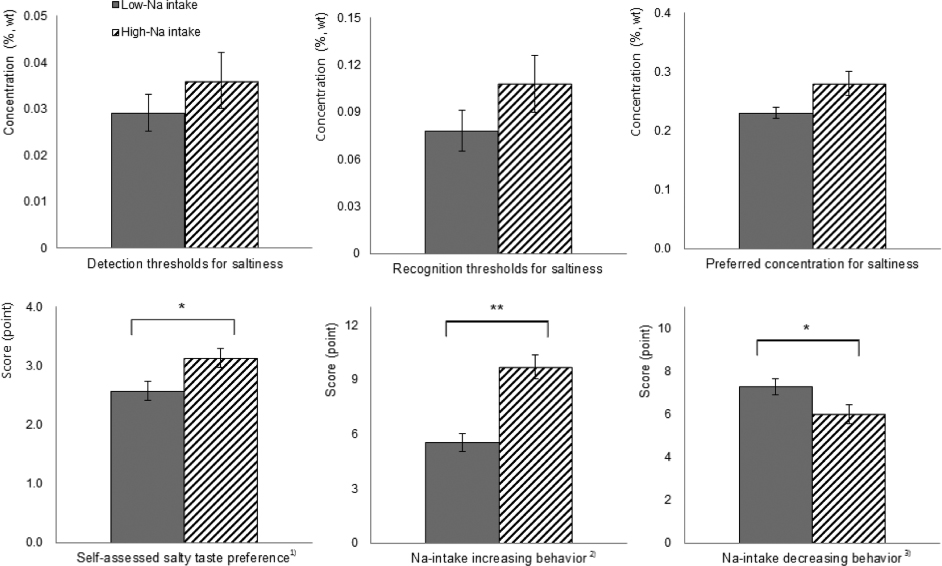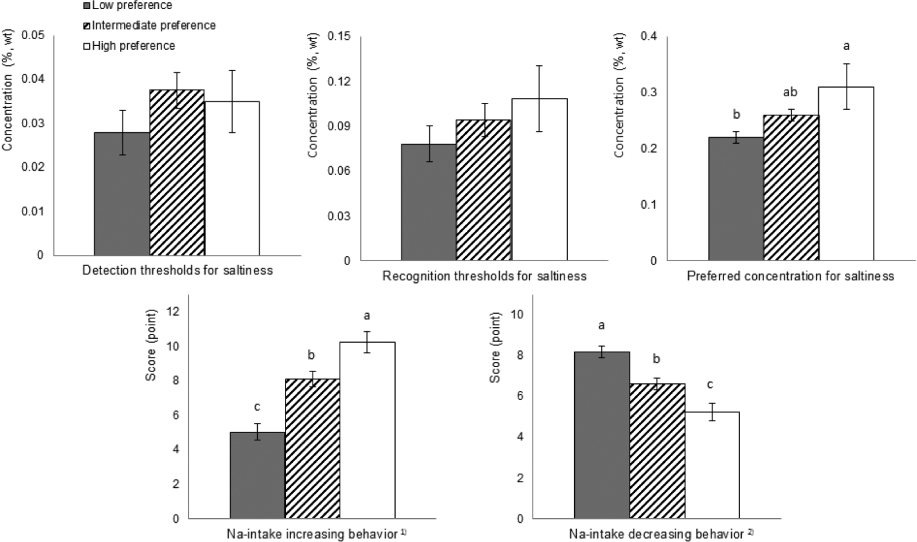J Nutr Health.
2016 Apr;49(2):88-98. 10.4163/jnh.2016.49.2.88.
Relationship between thresholds and self-assessed preference for saltiness and sodium intake in young women
- Affiliations
-
- 1Department of Food and Nutrition, Soongeui Women's College, Seoul 04628, Korea. rdyang@sewc.ac.kr
- 2Department of Food and Nutrition, Dongduk Women's University, Seoul 02748, Korea.
- KMID: 2209846
- DOI: http://doi.org/10.4163/jnh.2016.49.2.88
Abstract
- PURPOSE
We recruited 118 women in their early 20's to examine the relationship between sodium intake and salty taste thresholds and preference. We also examined the association of salty taste preference with sodium-related dietary behaviors and major dishes contributing to sodium intake.
METHODS
Daily sodium intake was estimated using a 127-item dish-frequency questionnaire. Salty taste thresholds and preference were measured using rating scales using water solution of NaCl and a self-administered questionnaire based on a Likert scale, respectively.
RESULTS
Salty taste preference showed positive correlation with daily sodium intake and sodium intake-increasing behaviors, and inverse association with sodium intake-decreasing behaviors, including salt and soy sauce use at the table, the frequency of eating out and home delivery of foods, broth consumption of soup, stew or noodle soup, the use of ready-to-serve or processed foods, fresh vegetable intake, and the accommodating attitude toward bland food. Intake of sodium-contributing dishes, including ramen, spicy soft-tofu stew, radish kimchi, and dishes containing kimchi, also showed positive association with salty taste preference. Unexpectedly, detection and recognition thresholds of salty taste showed no association with salty taste preference, sodium intake, and sodium-related dietary behaviors.
CONCLUSION
These findings suggest that salty taste preference could reflect sodium intake of individuals rather than thresholds of saltiness, and may be used as a simple and effective proxy for usual sodium intake.
MeSH Terms
Figure
Cited by 2 articles
-
Correlation analysis of sodium-related knowledge, dietary behavior, attitudes towards a low-salt diet and meal attitude guidance for elementary school teachers in Jeonbuk area
Hyun Ok Moon, Jeong Ok Rho
J Nutr Health. 2017;50(2):180-191. doi: 10.4163/jnh.2017.50.2.180.Customers' Perceptions of Operational Status of and Needs for Sodium Reduction in the Industry Foodservice in Seoul
Na-Young Yi
Korean J Community Nutr. 2020;25(1):21-31. doi: 10.5720/kjcn.2020.25.1.21.
Reference
-
1. Chobanian AV, Hill M. National Heart, Lung, and Blood Institute Workshop on sodium and blood pressure: a critical review of current scientific evidence. Hypertension. 2000; 35(4):858–863.2. Chobanian AV, Bakris GL, Black HR, Cushman WC, Green LA, Izzo JL Jr, Jones DW, Materson BJ, Oparil S, Wright JT Jr, Roccella EJ. Joint National Committee on Prevention, Detection, Evaluation, and Treatment of High Blood Pressure. National Heart, Lung, and Blood Institute. National High Blood Pressure Education Program Coordinating Committee. Seventh report of the joint national committee on prevention, detection, evaluation, and treatment of high blood pressure. Hypertension. 2003; 42(6):1206–1252.
Article3. Ministry of Health and Welfare, Korea Centers for Disease Control and Prevention. Korea Health Statistics 2014: Korea National Health and Nutrition Examination Survey (KNHANES VI-2). Sejong: Korea Centers for Disease Control and Prevention;2015.4. The Korean Nutrition Society. Dietary reference intakes for Koreans. Seoul: The Korean Nutrition Society;2005.5. Sacks FM, Svetkey LP, Vollmer WM, Appel LJ, Bray GA, Harsha D, Obarzanek E, Conlin PR, Miller ER 3rd, Simons-Morton DG, Karanja N, Lin PH, Aickin M, Most-Windhauser MM, Moore TJ, Proschan MA, Cutler JA. DASH-Sodium Collaborative Research Group. Effects on blood pressure of reduced dietary sodium and the Dietary Approaches to Stop Hypertension (DASH) diet. N Engl J Med. 2001; 344(1):3–10.
Article6. Bibbins-Domingo K, Chertow GM, Coxson PG, Moran A, Lightwood JM, Pletcher MJ, Goldman L. Projected effect of dietary salt reductions on future cardiovascular disease. N Engl J Med. 2010; 362(7):590–599.
Article7. Fregly MJ. Estimates of sodium and potassium intake. Ann Intern Med. 1983; 98(5 Pt 2):792–799.
Article8. Kim KS, Paik HY. A comparative study on optimum gustation of salt and sodium intake in young and middle-aged Korean women. Korean J Nutr. 1992; 25(1):32–41.9. Song DY, Park JE, Shim JE, Lee JE. Trends in the major dish groups and food groups contributing to sodium intake in the Korea National Health and Nutrition Examination Survey 1998-2010. Korean J Nutr. 2013; 46(1):72–85.
Article10. Manley KJ, Haryono RY, Keast RS. Taste changes and saliva composition in chronic kidney disease. Ren Soc Australas J. 2012; 8(2):56–60.11. Kusaba T, Mori Y, Masami O, Hiroko N, Adachi T, Sugishita C, Sonomura K, Kimura T, Kishimoto N, Nakagawa H, Okigaki M, Hatta T, Matsubara H. Sodium restriction improves the gustatory threshold for salty taste in patients with chronic kidney disease. Kidney Int. 2009; 76(6):638–643.
Article12. Michikawa T, Nishiwaki Y, Okamura T, Asakura K, Nakano M, Takebayashi T. The taste of salt measured by a simple test and blood pressure in Japanese women and men. Hypertens Res. 2009; 32(5):399–403.
Article13. McMahon EJ, Campbell KL, Bauer JD. Taste perception in kidney disease and relationship to dietary sodium intake. Appetite. 2014; 83:236–241.
Article14. Takachi R, Ishihara J, Iwasaki M, Ishii Y, Tsugane S. Self-reported taste preference can be a proxy for daily sodium intake in middle-aged Japanese adults. J Acad Nutr Diet. 2014; 114(5):781–787.
Article15. Lee H, Cho HJ, Bae E, Kim YC, Kim S, Chin HJ. Not salt taste perception but self-reported salt eating habit predicts actual salt intake. J Korean Med Sci. 2014; 29:S91–S96.
Article16. Pangborn RM, Pecore SD. Taste perception of sodium chloride in relation to dietary intake of salt. Am J Clin Nutr. 1982; 35(3):510–520.
Article17. Teow BH, Di Nicolantonio R, Morgan TO. Sodium chloride preference and recognition threshold in normotensive subjects on high and low salt diet. Clin Exp Hypertens A. 1985; 7(12):1681–1695.
Article18. Drewnowski A, Henderson SA, Driscoll A, Rolls BJ. Salt taste perceptions and preferences are unrelated to sodium consumption in healthy older adults. J Am Diet Assoc. 1996; 96(5):471–474.
Article19. Chobanian AV, Bakris GL, Black HR, Cushman WC, Green LA, Izzo JL Jr, Jones DW, Materson BJ, Oparil S, Wright JT Jr, Roccella EJ. National Heart, Lung, and Blood Institute Joint National Committee on Prevention, Detection, Evaluation, and Treatment of High Blood Pressure. National High Blood Pressure Education Program Coordinating Committee. The seventh report of the joint national committee on prevention, detection, evaluation, and treatment of high blood pressure: the JNC 7 report. JAMA. 2003; 289(19):2560–2571.
Article20. Ahn EJ, Noh HY, Chung J, Paik HY. The effect of zinc status on salty taste acuity, salty taste preference, sodium intake and blood pressure in Korean young adults. Korean J Nutr. 2010; 43(2):132–140.
Article21. Kim SH, Jang SY, Choi JK. Taste preference and whole-mouth taste threshold in a Korean population in the age of the 3rd decade. J Korean Acad Oral Med. 2003; 28(4):413–426.22. Shin EK, Lee HJ, Ahn MY, Lee YK. Study on the development and evaluation of validity of salty taste assessment tool. Korean J Nutr. 2008; 41(2):184–191.23. Chung EJ, Ryu HJ, Shim E. Major dishes contributing absolute and between-person sodium intake variations in university students in Gyeonggi-do. J Korean Soc Food Sci Nutr. 2016; 45(3):409–419.
Article24. Son SM, Park YS, Lim WJ, Kim SB, Jeong YS. Development and evaluation of validity of short dish frequency questionnaire (DFQ) for estimation of habitual sodium intake for Korean adults. Korean J Community Nutr. 2007; 12(6):838–853.25. Park YS, Son SM, Lim WJ, Kim SB, Chung YS. Comparison of dietary behaviors related to sodium intake by gender and age. Korean J Community Nutr. 2008; 13(1):1–12.26. He J, Ogden LG, Vupputuri S, Bazzano LA, Loria C, Whelton PK. Dietary sodium intake and subsequent risk of cardiovascular disease in overweight adults. JAMA. 1999; 282(21):2027–2034.
Article27. Shim E, Ryu HJ, Hwang J, Kim SY, Chung EJ. Dietary sodium intake in young Korean adults and its relationship with eating frequency and taste preference. Nutr Res Pract. 2013; 7(3):192–198.
Article28. Anderson CA, Appel LJ, Okuda N, Brown IJ, Chan Q, Zhao L, Ueshima H, Kesteloot H, Miura K, Curb JD, Yoshita K, Elliott P, Yamamoto ME, Stamler J. Dietary sources of sodium in China, Japan, the United Kingdom, and the United States, women and men aged 40 to 59 years: the INTERMAP study. J Am Diet Assoc. 2010; 110(5):736–745.
Article29. Kim GH, Lee HM. Frequent consumption of certain fast foods may be associated with an enhanced preference for salt taste. J Hum Nutr Diet. 2009; 22(5):475–480.
Article30. Kim HJ, Paik HY, Lee SY, Shim JE, Kim YS. Salt usage behaviors are related to urinary sodium excretion in normotensive Korean adults. Asia Pac J Clin Nutr. 2007; 16(1):122–128.31. Kim MH, Kim H, Lee WK, Kim SJ, Yeon JY. Food habits and dietary behavior related to using processed food among male college students residing in dormitory and self-boarding in Gangwon. Korean J Community Nutr. 2013; 18(4):372–385.
Article32. Kim MK, Hur YK, Choi JK. Interrater and intrater reliability of 'sip-and swallow'method for measurement of whole-mouth taste threshold. J Korean Acad Oral Med. 2004; 29(2):143–151.33. Leshem M. Biobehavior of the human love of salt. Neurosci Biobehav Rev. 2009; 33(1):1–17.
Article34. Warren RP, Pfaffmann C. Early experience and taste aversion. J Comp Physiol Psychol. 1959; 52(3):263–271.
Article35. Li Q. A novel Likert scale based on fuzzy sets theory. Expert Syst Appl. 2013; 40(5):1609–1618.
Article36. Cho YY. Practice guidelines for reducing salt intake. Korean J Community Nutr. 2002; 7(3):394–400.37. Carstens E, Carstens MI, Dessirier JM, O'Mahony M, Simons CT, Sudo M, Sudo S. It hurts so good: oral irritation by spices and carbonated drinks and the underlying neural mechanisms. Food Qual Prefer. 2002; 13(7-8):431–443.
Article
- Full Text Links
- Actions
-
Cited
- CITED
-
- Close
- Share
- Similar articles
-
- Zinc Status and Taste Acuity of Old and Young Women
- Salt Preference and Sodium Intake among Pregnant Women
- Dietary sodium intake in young Korean adults and its relationship with eating frequency and taste preference
- Calcium Status and Bone Mineral Density by the Level of Sodium Intake in Young Women
- The Effect of Zinc Status on Salty Taste Acuity, Salty Taste Preference, Sodium Intake and Blood Pressure in Korean Young Adults



